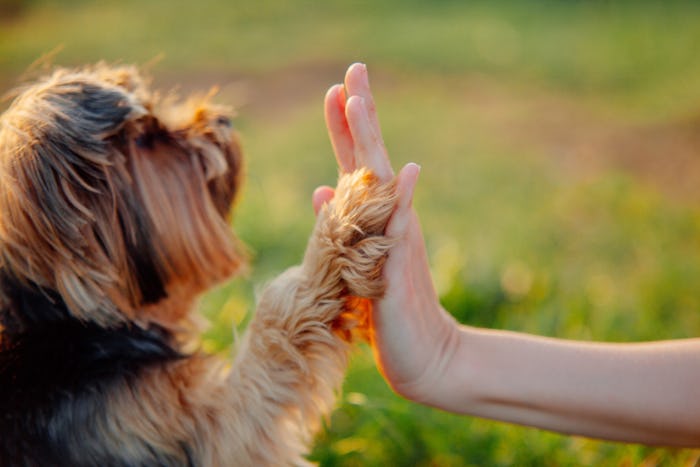Life
They may be your best friend, but dogs communicate very differently than people. Sometimes the dogs' messages get lost in translation, even when the owner has only the best intentions at heart. That's why the ways you're totally misreading your dog are so important to understand. Your dog is communicating with you all day long, but sometimes the subtle messages get overlooked.
To learn more, Romper reached out to two excellent professional dog trainers who have years of experience with all sorts of canines. Devan Amundsen is a certified dog trainer and behavior consultant with the Petaluma Animal Services Foundation, and its website is at ArmyOfKindness.net. He is also an instructor at Bergin College of Canine Studies. Linda Keehn is a certified professional dog trainer and dog behavior consultant at Positive Canine Training and Services. She has worked as a trainer for over five years, and she has experience with rescue dogs and therapy dogs as well. They agree that effective communication with your dog is crucial. "So much grief for dogs and humans could be avoided if we understood better what our dogs are trying to tell us," said Keehn. Thanks to their years of professional insight, these trainers can make communicating with your pup easier than ever.
1
Dominant Behaviors
Both trainers had a lot to say about so-called dominant behaviors in dogs. Basically? They're often misunderstood entirely.
"My stomach sinks immediately when I hear that an owner has been treating their dog as if it is ‘aggressive’ or ‘dominant,’ when in reality their dog is fearful," said Amundsen. Too often these dogs are punished for their behavior, when instead they need reassurance.
At other times, the seemingly aggressive behavior is just your dog's way of saying hello. For instance, dogs who jump on their owners are sometimes perceived as dominant. In reality, dogs are often jumping up as a way of greeting, as Keehn explained. When dogs greet one another, they often sniff faces. So a jumping dog often just wants a closer look at your face to say hi. There's nothing dominant about the behavior at all. To redirect this behavior, though, you can teach the dog to sit, or just bend down to their level so they can sniff your face for a few seconds.
2
Aggressive Chewing
Does your puppy try to chew on your sweater, fingers, and everything else in sight? It isn't necessarily a sign of misbehavior. "I often get calls from people who think their puppy is becoming aggressive when they are nipping at people and clothes," said Keehn. But chewing is just a normal part of puppyhood. Like human babies, puppies teethe and explore the world with their mouths.
Providing your puppy with a better way to direct that chewing energy is key. Make sure they have lots of chew toys handy, as Keehn explained. Redirect the pup to these legal chew toys when they start gnawing on clothes, furniture, or people.
3
Submissive Body Language
Dog behaviors that appear shy or submissive to people can actually mean the dog is super nervous and uncomfortable. "Lowering their body, squinting their eyes slightly, putting their ears back, slow deliberate movements, and freezing are all signs that your dog may be uncomfortable and needs to get out of the situation before things escalate," said Amundsen. It's important to recognize these fearful behaviors before they escalate to growling or even biting.
4
Subtle Stress Signs
Likewise, stressed-out dogs often give signals that people miss entirely. A dog that turns his head away, licks his nose, or pins his ears back may be stressed or scared, as Keehn explained. When the dog looks to the side so you can see the whites of his eyes, also known as a whale eye, then he's probably pretty stressed out, as Keehn further explained. It's time to give your dog a break from whatever is going on.
5
Happy Tail Wagging
As it turns out, a wagging tail isn't always a sign of happiness. In fact, tail wagging is a sign of adrenaline, as Amundsen explained. "While I have plenty of adrenaline flowing when I’m happy, I have MORE adrenaline flowing when I’m angry, frustrated, or scared. A happy tail is in line with the dog’s spine or slightly high, and wagging loose. Extremely high ‘flagging’ tails that are wagging fast and tight are likely more indicative of negative emotions," said Amundsen. Look for that loosely wagging tail to show your pup is happy.
6
Growling
When dogs feel very uncomfortable, they might start growling. But it's one sign you want to let the dog express. "We never want to punish a growl even verbally because it is an important warning for the humans. A dog that has learned not to growl may bite without giving that important warning signal," said Keehn. You want the dog to have a full range of ways to express his discomfort, and the growl is a very important signal.
7
Biting
Both trainers agree that biting is often the dog's last line of defense, and that several different types of body language often precede a bite. Instead of aggression, however, bites often show that dogs are terrified, as Amundsen noted. It's important to pay attention to your dog's escalating signs of distress, including pinned ears and growling, so that he doesn't have to resort to biting. Of course, if you have any individual concerns about your own dog's behavior, don't hesitate to contact a dog trainer for advice. Being able to read your dog is a crucial, and ultimately rewarding, part of your relationship.
